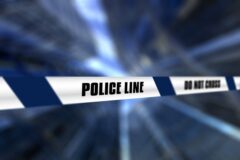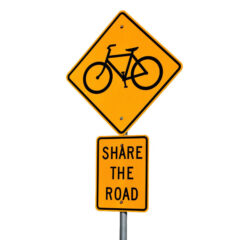Bike crashes are categorized based on what was the primary cause of an incident. These categorizations are used in later pages that contain advice on how some types of crashes might be avoided.

Page contents:
- Crash category 1 – Vehicle-bicycle collisions that are mostly the fault of the driver
- Crash category 2 – Bicycle-vehicle collisions that are mostly the fault of the cyclist
- Crash category 3 – Bicycle crashes in which no other vehicle is involved
- Discussion
Throughout this section, I use the words crash, collision and incident and never the word accident. This is because despite car crashes being referred to as car accidents by default, some people, including myself, feel that this terminology is inappropriate (see here and here). Accident is inappropriate and often misleading because describing something in this way presupposes that there is no blame and that the crash was unavoidable, but most of the time that is not the case because someone could have made a different judgment or behaved more responsibly to prevent the crash from happening. We never talk about “plane accidents” only ever “plane crashes”, so why do we refer to car crashes as “car accidents” by default?
I acknowledge that most bike crashes involve a complex combination of causes and fault is rarely all-or-none. However, for the current purpose it is easier to simplify things to allow use to talk about certain kinds of crashes and causes
| Label | Cause | Examples and avoidance advice |
|---|---|---|
| Category 1 – Vehicle-bicycle collisions that are at least mostly the fault of the driver: | ||
| 1a | The driver fails to see the cyclist. | A subset (but far from all) of such incidents can be avoided by using the advice in the Active Lighting and Passive Lighting pages and riding as if every driver doesn’t see you. |
| 1b | The driver sees the cyclist but makes an error of judgment. | Riding extremely defensively can help to avoid some such incidents and it’s often best to assume that all drivers are incompetent. The Avoiding Bike Crashes & What To Do If You Crash page contains advice about how to avoid some common situations. |
| 1c | The driver sees the cyclist and intentionally hits the cyclist. | Such incidents are fortunately very rare and some can be avoided by not riding too aggressively and staying calm at all times. |
| Category 2 – Bicycle-vehicle collisions that are at least mostly the fault of the cyclist: | ||
| 2a | The cyclist fails to see the vehicle. | Such incidents most often involve cyclists hitting parked cars, but occasionally cyclists may be at fault for colliding with moving vehicles that they haven’t seen, for example when coming around a bend too quickly on the wrong side of the road or not looking for traffic before crossing an intersection. It’s important to always be alert, which is covered on the Sleep Deprivation page. |
| 2b | The cyclist sees the vehicle but makes an error of judgment. | Some useful advice about bike handling skills is given on the Riding Technique & Efficiency and Avoiding Bike Crashes & What To Do If You Crash pages.. |
| 2c | The cyclist sees the vehicle and intentionally hits it. | Intentionally hitting a vehicle is likely to result in far more damage to the bike and rider than the vehicle and so such incidents can be ignored because they are so rare and are avoidable. |
| Category 3 – Bicycle crashes in which no other vehicle is involved: | ||
| 3a | An unexpected change in the road surface or other unexpected hazard appears. | Unexpected hazards could include pedestrians and animals suddenly entering a cyclist’s path. By definition, unexpected hazards are hard to avoid but you should try to anticipate as much as possible and ride within the limits of the road conditions and situation. It’s important to always be alert, which is covered on the Sleep Deprivation page. |
| 3b | The cyclist makes an error of judgment. | For example, not braking enough before a corner, overestimating the degree of grip on a wet road, etc. Some useful advice about bike handling skills is given on the Riding Technique & Efficiency and Avoiding Bike Crashes & What To Do If You Crash pages. |
| 3c | An animal attacks the cyclist. | Dogs and bears are the two animals most commonly encountered by cyclists that could attack them. See the Dealing With Animals While Cycling page. |
| 3d | The bike has a mechanical failure. | Most mechanical failures aren’t very sudden and can be prevented by selecting reliable components and properly maintaining the bike; see the Other Safety Equipment for Cyclists, Bike & Bike Components and Bike Maintenance pages. |
Discussion
An unfortunate effect of listing so many different types of bike crashes is that it will greatly increase the perceived likelihood of any crash happening (an effect known as unpacking in cognitive psychology), so please remember that cycling is generally a very safe activity and should not be thought of as inherently dangerous.
The overall risk of cycling is covered on the next page on Degree of Risk of Cycling & Doing Bikepacking Races. Some people have attempted to estimate the relative frequencies of different types of crashes, but because such estimates are highly debatable and are not particularly useful for the current purpose, I avoid making any such judgments.
Last significant page update: December, 2017
This page is in the Rider Health & Safety section. The next page in this section is:

